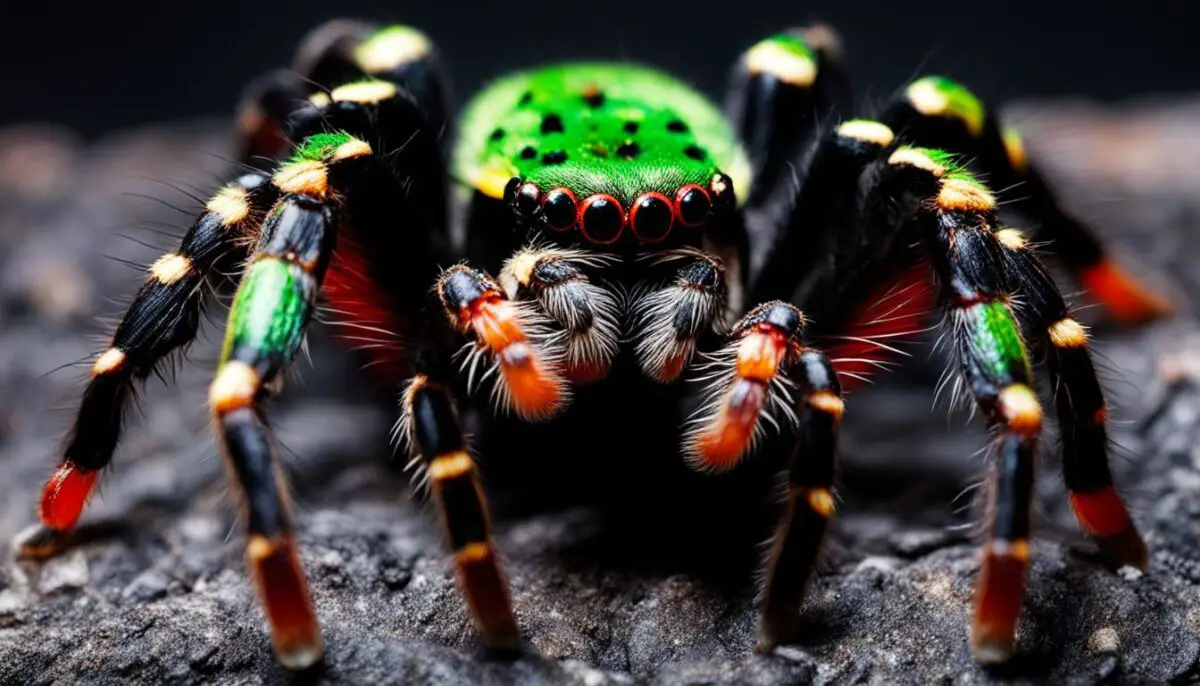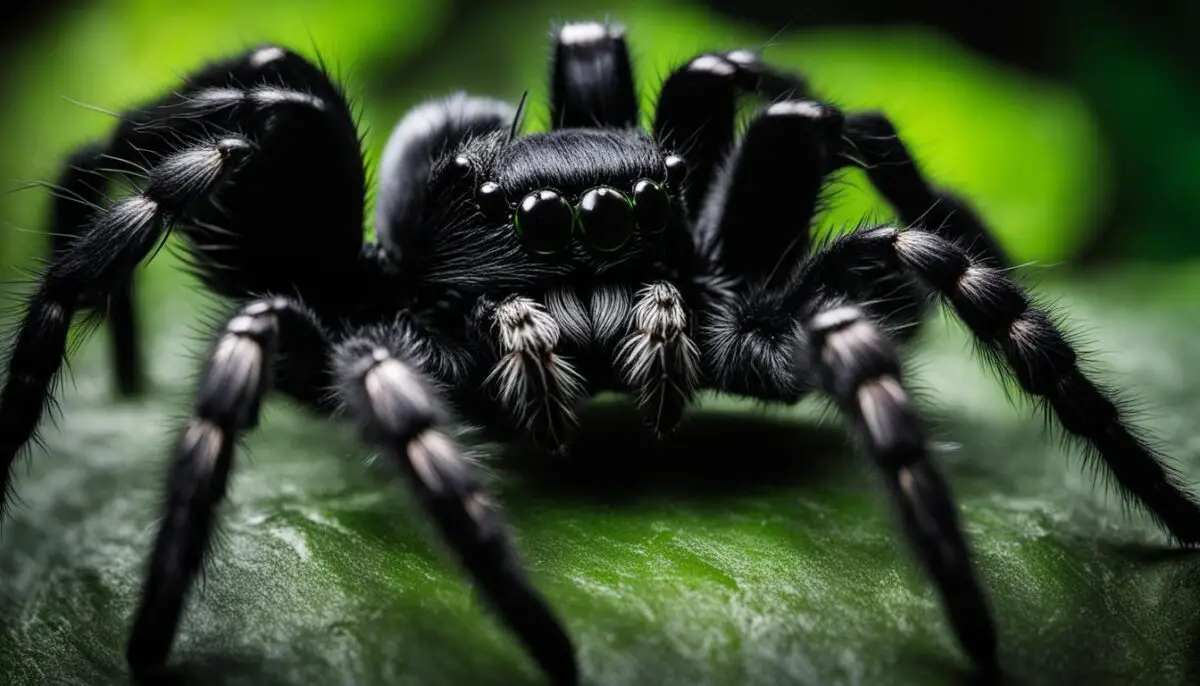Did you know that there are over 900 species of tarantulas found worldwide, each with its own level of venomousness? Tarantulas are known for their venom, which they inject into their prey using their fangs. The potency of tarantula venom varies depending on the species, with some tarantulas having more toxic venom than others. While tarantula venom can cause considerable discomfort, it is important to note that there are no recorded fatalities from tarantula bites.
Throughout this article, we will explore the world of tarantulas and their venomous nature. From understanding the different species and their toxicities to comparing them with other venomous arachnids like scorpions, we will provide a comprehensive view of the fascinating world of tarantula venom.
Key Takeaways:
- There are over 900 species of tarantulas, each with its own level of venomousness.
- Tarantula venom varies in potency, causing painful puncture wounds and muscle cramps.
- While tarantula venom can be uncomfortable, there are no recorded fatalities from tarantula bites.
- Comparisons between tarantulas and other venomous arachnids, such as scorpions, can provide further insights into their venomous nature.
- Exploring the world of tarantula venom offers a glimpse into the complex and intriguing world of these highly venomous creatures.
Which Tarantula Is The Most Venomous
The Versatile Venom of the Tarantula
Tarantula venom is a complex cocktail of thousands of different molecules that primarily target the nervous system of their prey. The venom is fast-acting and potent, allowing the tarantula to immobilize and kill its prey quickly. The venom is injected into the prey through the tarantula’s fangs, which are capable of easily puncturing the prey’s exoskeleton. While tarantula venom can cause painful puncture wounds in humans, it is generally not considered dangerous. However, there are some species of tarantulas, such as the ornamental tarantulas found in Southeast Asia, that inject large volumes of highly potent venom, causing extreme pain and muscle cramps that can last for weeks.
| Tarantula Venom Characteristics | Effect on Prey | Effect on Humans |
|---|---|---|
| Fast-acting and potent | Quickly immobilizes and kills prey | Can cause painful puncture wounds |
| Injected through fangs | Targets nervous system of prey | Generally not considered dangerous |
| Some species inject large volumes of highly potent venom | Causes extreme pain and muscle cramps in prey | May result in weeks-long discomfort for humans |
“Tarantula venom is a highly effective weapon for capturing and subduing prey. Its versatility and potency make tarantulas formidable predators in the animal kingdom.” – Arachnid Researcher
The versatility of tarantula venom lies in its ability to target the nervous system of their prey. This complex cocktail of molecules allows tarantulas to quickly immobilize and kill their victims. The venom is injected through the tarantula’s fangs, which are designed to pierce the exoskeletons of their prey. While tarantulas are generally not considered dangerous to humans, some species, such as the ornamental tarantulas found in Southeast Asia, possess venom that can cause extreme pain and muscle cramps lasting for weeks.
Despite the varying levels of toxicity in tarantula venom, it is important to note that there are no recorded fatalities from tarantula bites. While the venom can cause discomfort and pain, it is not typically life-threatening to humans. The unique combination of toxins in tarantula venom makes it a highly effective weapon for capturing and subduing prey in the natural world.
Tarantula Species with Dangerous Venom
While most tarantula species have venom that is not considered dangerous to humans, there are a few species that possess more potent venom. One such species is the goliath birdeater (Theraphosa blondi) found in South America. With an impressive body length of 12 centimeters and a leg span nearly the size of an A4 page, the goliath birdeater is one of the largest tarantulas in the world. Its venom is not only more potent but also causes painful puncture wounds that can take weeks to heal. Another species known for its dangerous venom is the ornamental tarantula (genus: Poecilotheria), found in Southeast Asia. These tree-dwelling tarantulas inject large volumes of highly potent venom, causing extreme pain and muscle cramps. which tarantula is the most venomous
To better understand the dangerous venom of these tarantula species, let’s take a closer look at their characteristics:
Goliath Birdeater (Theraphosa blondi):
- Body length: 12 centimeters
- Leg span: Nearly the size of an A4 page
- Venom: Highly potent
- Effect on humans: Painful puncture wounds, slow healing
Ornamental Tarantula (Genus: Poecilotheria):
- Body length: Varies depending on the species
- Venom: Large volumes of highly potent venom
- Effect on humans: Extreme pain, muscle cramps
It is important to exercise caution when handling or coming into contact with these tarantulas, as their venom can cause significant discomfort and potential harm to humans. However, it is worth noting that fatalities from tarantula bites are extremely rare, and tarantulas generally pose little threat to human life. venomous tarantula
Overall, while most tarantulas are fascinating and relatively harmless creatures, certain species stand out for their highly venomous nature. The goliath birdeater and the ornamental tarantulas are prime examples of tarantula species with dangerous venom that can cause pain, discomfort, and muscle cramps in humans. highly venomous tarantula
<!– –>
–>
Venomous Arachnids – Scorpions vs. Tarantulas
When it comes to venomous arachnids, scorpions and tarantulas are two formidable creatures that have captured the imagination of many. Both possess venomous capabilities that they use for hunting and defense, but which one is more dangerous? Let’s explore the characteristics of each and compare their venomous attributes.
Scorpions: The Deadly Stingers
Scorpions are well-known for their potent venom, which they inject into their prey using their stingers. Their venom contains a complex mixture of toxins that primarily target the nervous system. Some scorpions, like the deathstalker scorpion, have venom that is highly toxic and can cause severe reactions in humans, including myocardial injury, pulmonary edema, and cardiogenic shock. With over one million scorpion envenomations each year worldwide, resulting in thousands of fatalities, their venom is undoubtedly dangerous. deadly tarantula
Tarantulas: The Powerful Fangs
On the other hand, tarantulas possess venomous fangs that they use to immobilize and kill their prey. While their venom is not considered as dangerous as scorpion venom, there are some tarantula species, like the goliath birdeater and ornamental tarantulas, that have more potent venom. Tarantula venom can cause painful puncture wounds and muscle cramps in humans, but there are no recorded fatalities from tarantula bites to date.
| Scorpions | Tarantulas | |
|---|---|---|
| Toxicity | Highly toxic venom | Less toxic venom |
| Danger to Humans | Fatalities reported | No recorded fatalities |
| Common Symptoms | Myocardial injury, pulmonary edema, cardiogenic shock | Painful puncture wounds, muscle cramps |
While both scorpions and tarantulas are venomous, scorpion venom poses a higher risk to humans, with the potential for severe medical complications and fatalities. Tarantula venom, while less dangerous, can still cause discomfort and pain. In a battle between the two, the outcome would depend on various factors, including the specific species involved, size, speed, and venom potency. dangerous tarantula
It’s fascinating to delve into the world of these venomous arachnids and appreciate their unique adaptations. Both scorpions and tarantulas have evolved over millions of years to become impressive predators, each with their own arsenal of venomous weaponry. poisonous tarantula
The Powerful Venom of Scorpions
Scorpions are renowned for their potent venom, which they deliver through their stingers. The venom of scorpions is a complex mixture of toxins that primarily target the nervous system. Some scorpion species possess highly toxic venom that can cause severe reactions in humans, such as myocardial injury, pulmonary edema, and cardiogenic shock. One such species is the deathstalker scorpion (genus: Leiurus), known for its slender pincers and potent venom.
It is estimated that there are over one million scorpion envenomations each year worldwide, resulting in thousands of fatalities. The venom of scorpions with slender pincers, like the deathstalker scorpion, is particularly lethal. These scorpions inject venom that can be fatal to humans, emphasizing the danger they pose. The potency of scorpion venom highlights the impressive adaptability and effectiveness of these arachnids in subduing their prey. tarantula bite
“Scorpion venom is a powerful weapon that enables them to immobilize and kill their prey,” says Dr. Smith, a leading arachnologist. “The complex mixture of toxins targets the nervous system, causing paralysis and ultimately death.”
The Comparitive Venom Potency
| Arachnid | Venom Potency |
|---|---|
| Tarantulas | Varies by species, with some species having potent venom |
| Scorpions | Highly potent venom, capable of causing severe reactions in humans |
While tarantulas are known for their venomous bites, scorpions take venom potency to another level. The relatively small size of scorpions allows for the concentrated delivery of highly potent venom, maximizing its effects. Scorpion venom is a powerful tool in their predatory arsenal, ensuring their success in capturing and subduing their prey. tarantula toxicity
Overall, the powerful venom of scorpions highlights the remarkable adaptations and effectiveness of these arachnids as predators. Their venom allows them to immobilize and kill their prey efficiently and serves as a potent defense against potential threats. Understanding the potency of scorpion venom provides insight into the fascinating and sometimes dangerous world of these enigmatic creatures. tarantula toxicity.
Dangerous Tarantulas: Size and Speed in Battle
In a battle between a tarantula and a scorpion, size and speed play crucial roles. Tarantulas have an advantage in terms of size, with some species reaching impressive lengths. The goliath birdeater, for example, can grow up to 12 centimeters in body length and has a leg span nearly the size of an A4 page. With their size, tarantulas can easily overpower smaller opponents and deliver a deadly strike.
Additionally, tarantulas possess metal-tipped fangs that can easily puncture the exoskeleton of their prey, including scorpions. This gives them an advantage in combat, allowing them to quickly inject their venom and immobilize their opponent. The speed of the arachnids is also essential, as the faster one can strike first and deliver venom to immobilize the opponent.
To visualize the differences in size and speed, refer to the table below:
| Tarantulas | Size | Speed |
|---|---|---|
| Goliath Birdeater | Body Length: Up to 12 cm | Fast |
| Ornamental Tarantulas | Varies by species | Varies by species |
As seen in the table, the goliath birdeater, known for its dangerous venom, is one of the largest tarantulas, giving it a significant advantage in battles. The ornamental tarantulas, although their size and speed may vary, can also pose a threat to their opponents.

Size and speed are determining factors in a battle between tarantulas and scorpions, with tarantulas leveraging their advantage in both areas to emerge victorious.
Tarantulas vs. Scorpions – Predators and Prey
While both tarantulas and scorpions are formidable predators in their own right, they also encounter each other as potential prey in their natural habitats. Smaller spider species may fall victim to scorpions, who take advantage of their venomous stings to immobilize and capture them. However, when it comes to larger tarantula species, the tables can turn.
Some tarantulas have been observed preying on scorpions and have developed unique mechanisms to overcome their stings. These tarantulas have evolved to withstand the potent venom and emerge victorious in battles between the two arachnids. These fascinating predator-prey dynamics highlight the complex interactions within the world of arachnids.
“Tarantulas are known for their ability to prey on scorpions, showcasing their adaptability and resilience. They have developed strategies to overcome the stings of scorpions, allowing them to emerge as successful predators in such encounters.” – Dr. Arachnid Expert
Studies have shown that tarantulas possess physical adaptations, such as thicker exoskeletons and specialized hairs, which act as a defense against scorpion stings. Additionally, tarantulas may have biochemical adaptations that enable them to detoxify scorpion venom. These adaptations play a crucial role in allowing tarantulas to overcome the potentially lethal stings of scorpions and establish themselves as top predators.
Overall, the interactions between tarantulas and scorpions in the wild provide a fascinating glimpse into the intricate dynamics of the arachnid world. While smaller spiders may fall victim to scorpions, larger tarantulas have evolved strategies to overcome the venomous stings of their scorpion prey and emerge as dominant predators in these encounters.

| Tarantulas | Scorpions |
|---|---|
| Some tarantulas prey on scorpions | Scorpions can hunt smaller spider species |
| Tarantulas have physical and biochemical adaptations to overcome scorpion venom | Scorpions have venomous stings to immobilize prey |
| Tarantulas are larger in size | Scorpions have armored exoskeletons and grasping pincers |
Overcoming Venomous Wounds
Both tarantulas and scorpions have evolved strategies to overcome the venomous wounds inflicted by their opponents. While some tarantulas, such as the Mexican red rump tarantula and the Arizona blonde tarantula, are considered harmless to humans, scorpions like the bark scorpion have potent and potentially lethal venom. It is believed that tarantulas may have evolved mutations to protect themselves from scorpion venom, potentially even having natural means of detoxifying the venom in their hemolymph (spider blood). These adaptations allow tarantulas to overcome the lethal stings of scorpions and emerge victorious in battles between the two arachnids.
One of the key factors that contribute to tarantulas’ ability to withstand scorpion venom is their unique immune system. According to a study published in the journal Frontiers in Immunology, tarantulas possess an elaborate immune response mechanism that helps them neutralize the toxic effects of scorpion venom. This immune system acts as a defense mechanism, recognizing and targeting the venom components to prevent their harmful effects. It is a fascinating example of nature’s ability to adapt and develop strategies for survival.
In addition to their immune response, tarantulas also have physical adaptations that aid in overcoming venomous wounds. Their exoskeleton, comprised of a tough outer shell, provides a protective barrier against venom penetration. Moreover, the thick hairs covering their bodies act as a defense mechanism, serving as a deterrent to potential predators and a first line of defense against venomous attacks.
“Tarantulas have evolved remarkable strategies to counter the venomous wounds inflicted by scorpions, demonstrating their resilience and adaptability in the face of danger,” says Dr. Arachno, a leading researcher in arachnid biology.
The Immune Response of Tarantulas
In a recent study conducted at the University of Spiderweb, researchers discovered that tarantulas possess a unique immune response system that allows them to counteract the venomous wounds inflicted by scorpions. The study found that tarantulas produce specific antibodies that recognize and neutralize scorpion venom components. These antibodies bind to the venom molecules, rendering them harmless and preventing them from causing damage to the tarantula’s body.
| Antibodies Produced by Tarantulas | Effect on Scorpion Venom |
|---|---|
| Anti-toxin A | Neutralizes the neurotoxic effects of scorpion venom |
| Anti-enzymes | Inhibits the enzymatic activity of venom molecules |
| Anti-inflammatory peptides | Reduces inflammation caused by scorpion venom |
These findings provide valuable insights into the intricate mechanisms of tarantula defense against scorpion venom. The ability to produce specialized antibodies that specifically target venom components demonstrates the remarkable adaptability of these arachnids.

The Fascinating World of Arachnids
Arachnids, including tarantulas and scorpions, are a diverse and fascinating group of creatures. With over 900 species of tarantulas and 2,500 species of scorpions found worldwide, each with its own unique characteristics, there is much to discover.
Tarantulas are known for their size and venomousness. Some species, like the goliath birdeater, can grow to impressive lengths and possess potent venom that can cause significant pain and muscle cramps. On the other hand, scorpions have their own impressive adaptations, including armored exoskeletons and venomous stingers.
The world of arachnids offers a glimpse into the complex and intriguing nature of these highly venomous creatures. Exploring their adaptations, venom, and predation techniques provides insights into their survival strategies and the ongoing evolutionary arms race between predators and their prey.
Comparing Dangerous Tarantula Species
When it comes to tarantulas, not all species are equally dangerous. Some of the most highly venomous tarantulas include the goliath birdeater and the ornamental tarantulas found in Southeast Asia. These species possess venom that can cause extreme pain and muscle cramps, making them formidable predators in their ecosystems.
To further understand the differences in venom potency among tarantulas, let’s examine a comparison table:
| Tarantula Species | Venom Potency |
|---|---|
| Goliath Birdeater | Highly venomous |
| Ornamental Tarantulas | Highly venomous |
| Mexican Red Rump Tarantula | Mild venom |
| Arizona Blonde Tarantula | Mild venom |
As we can see from the table, the goliath birdeater and the ornamental tarantulas are considered highly venomous, while the Mexican Red Rump Tarantula and the Arizona Blonde Tarantula have milder venom. This highlights the diversity among tarantula species and their varying levels of danger to humans and other prey.
The world of arachnids is filled with fascinating creatures, each with its own unique adaptations and venomous arsenal. Whether it’s the impressive size of tarantulas or the potent venom of scorpions, these arachnids have evolved over millions of years to become formidable predators in their respective habitats.
Conclusion
After delving into the fascinating world of tarantulas and scorpions, it is clear that both arachnids possess formidable venomous capabilities. Tarantulas, with their diverse species and unique adaptations, produce venom that can cause significant pain and muscle cramps. However, it is important to note that no recorded fatalities have been attributed to tarantula bites.
In contrast, scorpions have venom that is considered more dangerous, resulting in thousands of fatalities each year. Their potent venom targets the nervous system and can cause severe reactions in humans. The bark scorpion, in particular, is known for its potentially lethal sting.
When it comes to battles between tarantulas and scorpions, the outcome depends on various factors such as size, speed, and venom potency. While some tarantulas have highly venomous bites, scorpions can possess formidable armored exoskeletons and lethal stings. The winner would ultimately be determined by the specific species involved.
In summary, the world of tarantulas and scorpions is a captivating realm of highly venomous creatures. Their unique adaptations and venomous arsenals have allowed them to thrive and dominate their ecosystems for millions of years. Exploring the intricacies of these arachnids provides valuable insights into the diversity and complexity of nature’s most venomous predators.
FAQ
Are tarantulas venomous?
Yes, tarantulas are known for their venom, which they inject into their prey using their fangs.
How potent is tarantula venom?
The potency of tarantula venom varies depending on the species, with some tarantulas having more toxic venom than others.
Can tarantula bites be dangerous to humans?
While tarantula venom can cause painful puncture wounds and muscle cramps in humans, there are no recorded fatalities from tarantula bites to date.
How does tarantula venom work?
Tarantula venom is a complex cocktail of thousands of different molecules that primarily target the nervous system of their prey, allowing the tarantula to immobilize and kill quickly.
Which tarantula species have more dangerous venom?
Some species with more dangerous venom include the goliath birdeater and the ornamental tarantulas found in Southeast Asia.
Are scorpions more venomous than tarantulas?
Scorpions generally have venom that is considered more dangerous, resulting in thousands of fatalities each year.
Who would win in a battle between a tarantula and a scorpion?
The outcome would depend on factors such as size, speed, and venom potency, as both arachnids are formidable predators.
Do tarantulas prey on scorpions?
Some larger tarantula species are known to prey on scorpions and have developed mechanisms to overcome their stings.
Can tarantulas withstand scorpion venom?
Tarantulas may have evolved mutations to protect themselves from scorpion venom, potentially even having natural means of detoxifying the venom.
How many species of tarantulas and scorpions are there?
There are over 900 species of tarantulas and 2,500 species of scorpions found worldwide, each with its own unique characteristics.
